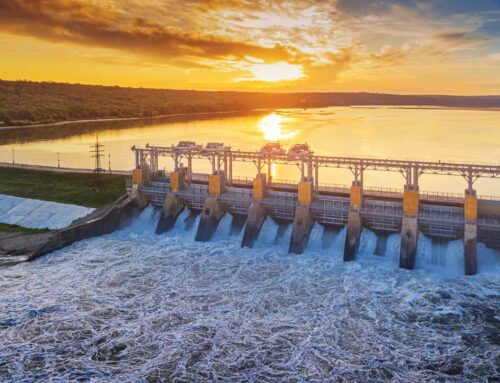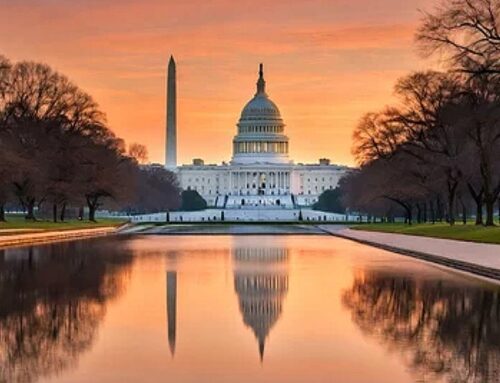NWC’s Federal Policy Spotlight
June 1, 2021
Happy First of June NWC members!
Below are some recent Federal Policy updates. The latest? President Biden released his full FY2022 budget proposal last week. We also dig into the latest on infrastructure, as well as happenings at federal agencies. As always, if you have any questions or comments, please do not hesitate to contact me. Have a wonderful week!
Best,
Julie Ufner
President and CEO
National Waterways Conference
LATEST IN THE NATION’S CAPITAL
Capitol Hill is on recess this week. Neither the U.S. House of Representatives nor the U.S. Senate have legislative business this week.
Biden released full FY2022 budget last week. On Friday, May 28, President Biden released his FY2022 comprehensive $6 trillion budget proposal which combines three of his key priorities—the $2.3 trillion American Jobs Plan, the $1.8 trillion American Families Plan and the $1.5 trillion for the annual FY2022 budget. The budget also focuses on addressing climate change and environmental justice and clean energy and infrastructure investments. The President’s budget is essentially the administration’s priority wish list for the FY2022 appropriations cycle. While NWC continues to analyze the proposed budget, some top-line agency highlights are below:
The U.S. Army Corps of Engineers Civil Works program would get $6.79 billion under the President’s budget (in FY2021, USACE received close to $7.8 billion). Of that, $2.45 billion is dedicated to commercial navigation, $1.72 billion for flood and storm damage reduction and $501 million for aquatic ecosystem restoration. According to the Administration, this is the highest ever proposed by a sitting President. The proposed budget works to address two key priorities: increasing resiliency and decreasing risk in localities due to climate change and addressing environmental justice issues in disadvantaged communities.
Highlighted below are several USACE accounts within the budget:
- Construction account. The budget provides $1.89 billion ($1.79 billion from Constructions, $62.7 million from Harbor Maintenance Trust Fund (HMTF) and $32.6 million from the Mississippi River and Tributaries account) and four new starts (McClellan-Kerr Arkansas River Navigation System, Three Rivers, AR; West Sacramento, CA; Anacostia Watershed Restoration, Prince George’s County, MD; and Norfolk Harbor and Channels, VA (Deepening). The budget also lowers the benefit cost ratio (BCR) from 2.5 to 1 to 2.0 to 1 or greater with a seven percent discount rate. As part of the America’s Jobs Plan proposal, the budget includes $2 billion over five years for the federal share of coastal navigation construction projects and $780 million for the 65 percent cost share for inland waterways construction projects.
- Investigations receives $113 million under the budget. This includes $29 million for technical and planning programs associated with climate change adaption, $17 million for research and development, $4 million for dredging projects in the Great Lakes and along the Mississippi River and $1 million toward figuring out how to incorporate climate change considerations into USACE’s planning and policy document. Additionally, the budget provides funding for climate-related new study starts in the Great Lakes and central and southern Florida areas.
- Mississippi River and Tributaries is given $275 million under the budget proposal.
- Harbor Maintenance Trust Fund (HMTF). Under the budget proposal, the President proposes to use almost $1.63 billion from the HMTF with an emphasis on O&M. Additionally, the Administration allots $787 million to the “top 50 U.S. coastal ports,” as well as to $252 million for O&M for Great Lakes projects.
- Inland Waterways Trust Fund (IWTF). Under the budget, $52.15 million of the IWTF would be used for construction for the McClellan-Kerr Arkansas River Navigation System, Three Rivers, AR project. Additionally, the budget notes under the president’s American Jobs Plan, inland navigation construction projects would receive $420 million over five years for the 35 percent cost share.
To read the FY2022 USACE civil works budget press package, click here. NWC will continue to read and analyze the proposed budget to assess how it may impact our members.
Maritime Administration (U.S. Department of Transportation). MARAD would receive $1.17 billion under the President’s budget. $81.7 million is requested for MARAD’s Operations and Programs which provides staff to help MARAD meet its core mission goals. The budget request also includes $10.8 million for Marine Highway Transportation grants to expand the use of the nation’s navigable waters; $230 million for the Port Infrastructure Development Program to improve port facilities; and $20 million for Small Shipyard Grants to provide funding for capitol and related improvements and/or training. For DOT and MARAD budget highlights, click here (MARAD, pg. 69).
Federal Emergency Management Agency (U.S. Department of Homeland Security). Under the budget proposal, FEMA would receive a little over $28 billion to focus on three key goals: building a culture of preparedness, preparing the nation for catastrophic disasters and reducing the complexity of FEMA grants. In FEMA’s Budget in Brief (FEMA Starts on page 65), it states the following: the Building Resilient Infrastructure and communities (BRIC) program would receive $500 million, the Flood Hazard Mapping and Risk Analysis Program (Risk Map) would receive $12.5 million, research until climate and nature-based solutions would be giving $5 million and $5million would be allotted for flood resilience measures.
Environmental Protection Agency (EPA). Under the President’s budget proposal, EPA would receive $11.23 billion for FY2022. This is approximately a $2 billion dollar increase over FY 2021 funding levels of $9.2 billion. Of that, $110 million is set aside to restaff the agency which lost close to 1,000 staffers in the past four years. Additionally, the budget proposes to increase the Diesel Emissions Reduction Act (DERA) grant program from $90 million in FY2021 to $150 million in FY2022. DERA aims to reduce emissions by providing grants to replace older diesel engines. The budget also includes an increased focus on environmental justice and intends to “aggressively pursue violations that threaten communities, ensure a level economic playing field by ensuring that violators do not realize an economic benefit from noncompliance, and deter future violations.” Under the water portfolio, the budget allots $1.8 billion for the Clean Water State Revolving Fund and $1.3 billion for the Drinking Water State Revolving Fund. Furthermore, the proposal gives $8 million for EPA’s successful Water Infrastructure Finance and Innovation Act (WIFIA) program. To read EPA’s Budget in Brief, click here.
Senate committee passes surface transportation bill. On May 26, the U.S. Senate Environment and Public Works Committee unanimously passed the bipartisan Surface Transportation Reauthorization Act (STRA). According to a committee press release, the “Surface Transportation Reauthorization Act of 2021 sets a new baseline funding level at a historic high of $303.5 billion for Department of Transportation programs for highways, roads, and bridges. This marks an increase of more than 34 percent from the last reauthorization to pass Congress, the FAST Act, in 2015.The prior authorization for surface transportation programs expired in 2020; Congress passed a one-year extension that will expire on September 30, 2021.” Full text of the Surface Transportation Reauthorization Act approved can be found here. Additional materials include a one-pager and tables for apportionments and authorizations.
Still no word on ASA (civil works) hearing. While President Biden nominated Michael Connor as Assistant Secretary of the Army for Civil Works in April, he will have to go through Senate Committee hearings before being confirmed by the Senate. As of press time, his nomination hearing has not been scheduled. In the meantime, Jamie Pinkham, USACE’s Principal Deputy Assistant Secretary of the Army, is currently serving as the Acting Assistant Secretary of the Army (Civil Works) until Connor is confirmed by the Senate.
Fate of infrastructure package is still uncertain. While President Biden originally wanted to conclude infrastructure negotiations by Memorial Day, there are indications that the talks continue. Last Thursday, Republicans proposed a counteroffer of $928 billion to Biden’s last $1.7 trillion proposal. The latest Republican plan continues to focus on “traditional” infrastructure—aka roads, bridges, water and transportation systems. Under the Republican proposal: $506 billion for roads and bridges, $98 billion for public transit systems, $46 billion passenger and freight rail, $21 billion for safety, $22 billion for ports and waterways, $56 billion for airports, $22 billion for western water storage, $72 billion for water infrastructure (drinking water/wastewater), $65 billion for broadband infrastructure and $20 billion for infrastructure financing. Biden called the proposal “encouraging” but continues to call for funding for social programs, climate change and other issues. And, both sides are still far apart on how to pay for the package. Biden would like to raise taxes on corporations and wealthier Americans but this is a non-starter for the Republicans. The Republicans propose to tap leftover COVID-19 stimulus relief funds as well as user fees which Democrats are reluctant to do. According to reports, the White House will continue negotiations for a few more days before moving toward how to pass the Administration’s package on Capitol Hill without Republican support.
FEDERAL AGENCY CORNER
EPA announces its intent to rewrite the Sec. 401 water certification rule. On May 27, U.S. Environmental Protection Agency (EPA) Administrator Michael Regan released a statement that announced EPA’s plans to revise the Sec. 401 water certification rule. The current Sec. 401 rule was revised under the Trump Administration who was concerned that the previous rule gave states too much authority to block energy infrastructure projects. Under the Trump rule (which is the current rule), states are only allowed to deny Sec. 401 water certifications if the project directly contributes pollutions to state waters. Additionally, under the rule, states have a one-year deadline to approve projects. Twenty states have sued the EPA over the rule.
EPA revokes Trumps “Secret Science” rule. Last week, the EPA finalized a rule that revokes President Trumps “secret science” rule. This now allows the agency to use studies where not all of the data is publicly available. This action by the EPW is consistent with a February court decision that ruled that the secret science rule was invalid due to process used to finalize it. EPA had classified the rule as procedural which allowed the rule to be finalized immediately, rather than using the typical 30 days.
President released funding in pre-disaster mitigation resources for climate resiliency. On May 24, President Biden announced new efforts to help communities prepare, adapt and mitigation against climate change. Of this, $1 Pre-Disaster Building Resilient Infrastructure and Communities (BRIC) program. According to FEMA, BRIC supports states, local communities, tribes, and territories in undertaking pre-disaster hazard mitigation projects, reducing the risks they face from disasters and natural hazards. In the press release, the Administration touts the steps they have taken to address climate change.
FEMA announces $12 million in grant funding for high hazard dams. On May 21, the Federal Emergency Management Agency (FEMA) announced that $12 million was available for its High Hazard Potential Dams (HHPD) Rehabilitation Grant program. This is a $2 million increase over FY2020. According to FEMA, eligible dams include those that are: located in a state or territory with a dam safety program; Classified as ‘high hazard potential’ by the dam safety agency in the state or territory where the dam is located; have a current, approved emergency action plan by the state or territorial dam safety agency or with current emergency action plan that is in conformance with state law and pending approval by the state or territorial dam safety agency; is located in a jurisdiction with a FEMA-approved Hazard Mitigation Plan that includes dam risk; is located in a state or territory in which determines the dam fails to meet minimum dam safety standards of the state or territory and is in a state or territory with an enacted dam safety program, the state administrative agency, or an equivalent state agency, is eligible to apply for the grant. Each eligible state may submit only one grant application. For more information, click here or here.



